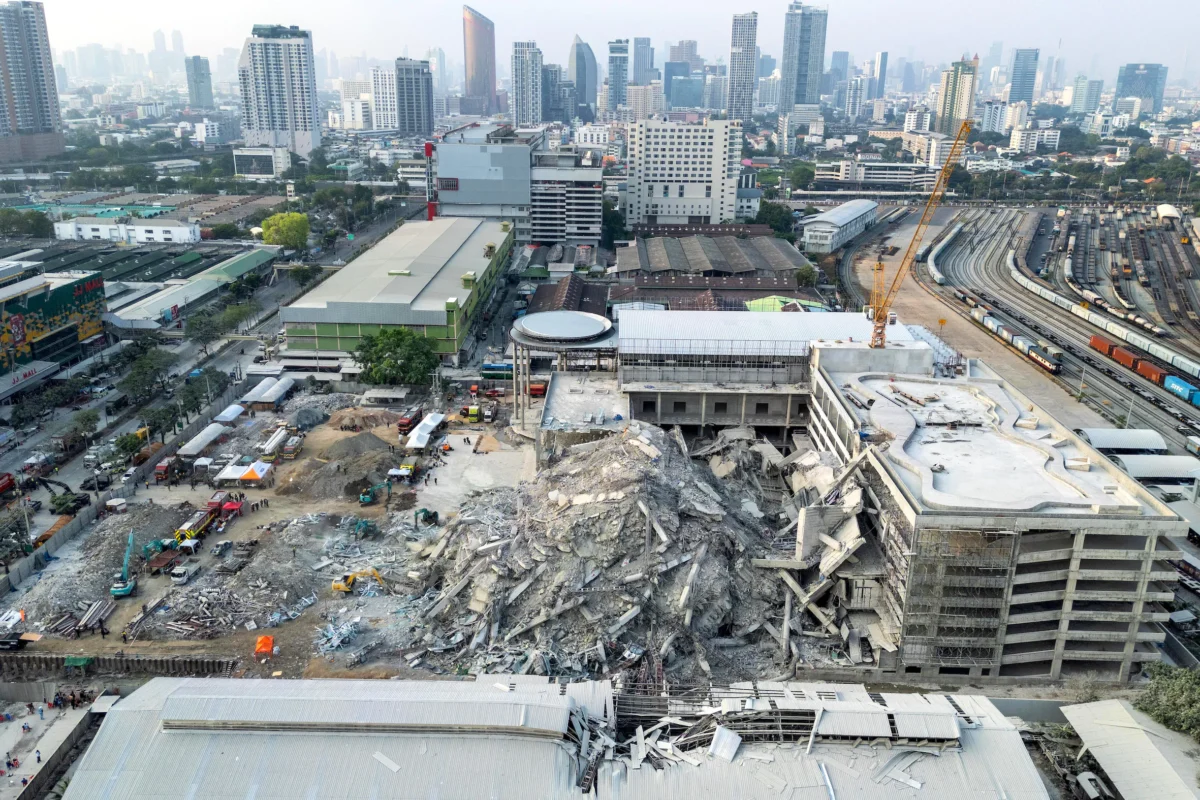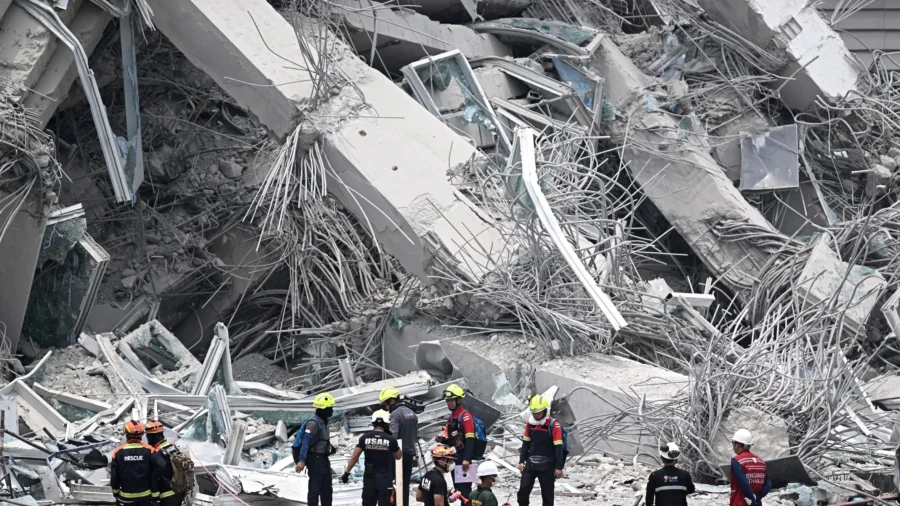The death toll reached more than 1,700, with many still missing in Burma, also known as Myanmar, the epicenter of the 7.7 magnitude earthquake that struck on March 28. USGS said on Sunday that a 5.1 magnitude aftershock has hit 13 miles northwest of Mandalay in Burma.
Meanwhile, the Thai government announced a probe on March 29 into a 33-story building that collapsed during the earthquake with nine workers confirmed killed and about 100 missing. The building was a joint Thai–China construction project.
Some glass windows installed as cladding on the building could be seen falling off as the entire structure collapsed within seconds. The cloud of dust that rose as the building collapsed into a mound was caught by witnesses in videos shared on social media.
The building, some 800 miles from the epicenter, was the only high-rise to collapse from the quake in Thailand.
Acknowledging public concerns at a March 29 press conference as to why only this one building collapsed in Bangkok while similar nearby structures remained intact, Thai Prime Minister Paetongtarn Shinawatra said that the government has ordered the Department of Public Works and Town and Country Planning to investigate what caused the structural failure of the high-rise structure, with a reporting deadline in a week.
Shinawatra said the department has also been asked to investigate those responsible for the building design and how the design, which was said to be a unique “core tube + flat slab” structure, was approved.
“I watched multiple clips of the building collapse from different angles. From my experience in the construction industry, I have never seen an issue like this,” the prime minister said. “We must investigate thoroughly because a significant portion of the budget was allocated, and the deadline for completion had been extended.”
The building, which had a scheduled completion date of Dec. 31, 2023, was to be used as Thailand’s new Office of the Auditor General.
The building was a $63 million joint venture between leading Thai construction company Italian-Thai Development Company, PLC, (ITD) and China Railway No. 10 Bureau Group Co., Ltd.
ITD has been facing a liquidity crisis due to significant debt obligations from delayed or problematic projects, many in war-torn Burma.
Local Thai media reported that a Chinese state-owned railway group, the China Railway Engineering Corporation (CREC), is the largest shareholder, with 49 percent of the shares in the China Railway No. 10 Bureau Group Co.—the maximum stake foreign companies can hold in a Thai company under Thai law.
CREC is heavily involved in China’s controversial Belt and Road Initiative (BRI) and China Railway No. 10 Bureau Group Co. is a primary contractor of the BRI Thai-China high-speed rail project connecting Bangkok to Laos and China, according to Chinese state-run media. Beijing hopes the new trade route will facilitate greater economic opportunities between the trading partners.
However, nations involved in other Belt and Road initiatives have warned of unsustainable debts incurred as a result of the projects, which have not delivered the advertised economic stimulation and growth but instead resulted in national security risks for host countries.
Structural Build Said to Be Finished
Construction on the building in Bangkok’s Chatuchak Weekend Market commercial area began in 2020 and was put on hold during the pandemic. Completion of the building’s structural components was announced by the China Railway No. 10 Bureau Group on April 3, 2024.
The group posted photos of the topping out of the building, with one photo showing workers holding a Chinese banner that reads, “Warm congratulations on the successful topping-out of the main structure of the Thailand Audit Office project undertaken by China Railway 10th Bureau.”
Topping out represents the completion of the structural phase of construction, with the highest point of the building having been put in place.
Following the building’s collapse, that news was quickly deleted from the group’s official website and social media channels.
According to Taiwan’s CNA, except for one report by Chinese financial outlet Caixin, Chinese media reports mostly avoided mention of the involvement of China Railway 10th Bureau with the building’s construction. The Caixin report has since been removed.
China’s media reports of the collapse only mention that construction was 30 percent complete.
CNA also noted that a now-censored Phoenix.com report had said that the main structure of the building was successfully topped out and that the project had entered the decoration and renovation stage of construction.
Phoenix reported that after completion, the building would “be a business card for China Railway 10th Bureau’s development in Thailand.”
Deputy Prime Minister and Interior Minister Anutin Charnvirakul told reporters while visiting the site the evening of the earthquake that some things seen in the collapse were highly unusual.
“I am not a structural engineer, but I looked at it … It shows that it did not collapse from above. It was a tear, a tear in the columns that support the weight of the entire building below. We have to look at how it was designed, but I believe they made allowances,” he said.
However, he encouraged people not to jump to conclusions to avoid panic about the cause of the collapse.
“Engineers have to set up models,” he said. “We shouldn’t speculate on this because it’s all based on science. If they design inadequately, it will say that the design is inadequate. If they design adequately, we will look at the new cause,” he said, pointing to building standards for earthquakes that “may have to be increased in the future.”

Workers Still Trapped
As of Saturday, nine workers were confirmed killed in the collapse, while around 100 were still missing.
Bangkok-based Khaosod English reported that a foreman with TTSW Engineering Limited working at a lower floor of the construction site told the outlet that he heard the concrete floor make cracking sounds about 10 minutes before the building collapsed. He said he was not able to identify which floor the cracking sound was originating from, the outlet said.
The foreman told the outlet that the timing of the quake was fortunate, as an upcoming shift change at 4 p.m. would have seen double the number of people on site.
Bangkok Gov. Chadchart Sittipunt said on Saturday that city authorities have received 6,000 reports of cracks in buildings across the capital. They are being investigated and the appropriate safety measures taken, he said.
Reuters contributed to this report.
From The Epoch Times

